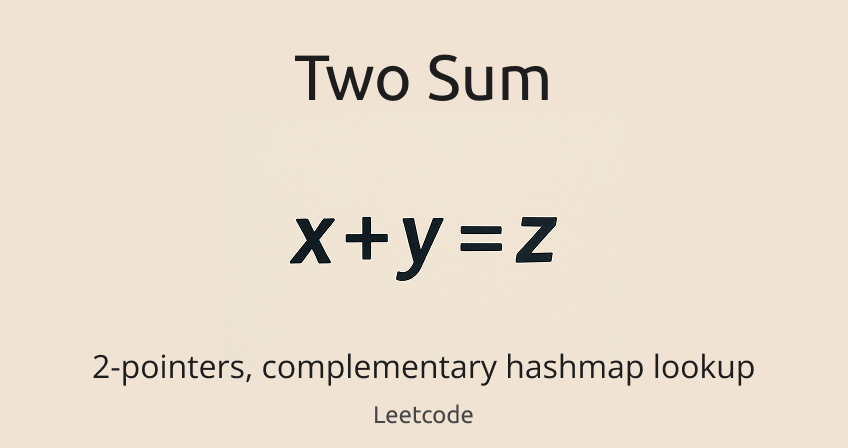Two Integer Sum
Sort, then use two-pointers: O(n log n) | Use HashMap to look up complementary number: O(n)

Sort, then use two-pointers: O(n log n) | Use HashMap to look up complementary number: O(n)

Problem:
Given an array of integers nums and an integer target, return indices of the
two numbers such that they add up to target.
You may assume that each input would have exactly one solution, and you may not
use the same element twice.
You can return the answer in any order.
Example 1:
Input: nums = [2,7,11,15], target = 9
Output: [0,1]
Explanation: Because nums[0] + nums[1] == 9, we return [0, 1].
Example 2:
Input: nums = [3,2,4], target = 6
Output: [1,2]
Example 3:
Input: nums = [3,3], target = 6
Output: [0,1]
Here are two ways in solving this problem.
First, sort the array while keeping track of original indices. Create two pointers,
Let left be the starting index (0)
Let right be the ending index (len(nums) - 1)
While left < right,
compute sum = nums[left] + nums[right].
if sum == target, we found our solution, lookup and return the pair original indices.
if sum < target, move left forward to increase the sum.
if sum > target, move right backward to decrease the sum.
class Solution:
@staticmethod
def twoSum(nums, target):
"""
:type nums: List[int]
:type target: int
:rtype: List[int]
"""
# Keep track of original indices by enumerating
indexed_nums = list(enumerate(nums)) # [(index, value), ...]
indexed_nums.sort(key=lambda x: x[1]) # sort by value
left, right = 0, len(indexed_nums) - 1
while left < right:
sum = indexed_nums[left][1] + indexed_nums[right][1]
if sum == target:
# Return original indices
return [indexed_nums[left][0], indexed_nums[right][0]]
elif sum < target:
left += 1
else:
right -= 1
return [] # if no solution found (though problem states one exists)
# Example usage
print(Solution.twoSum([3, 2, 4], 6)) # [1, 2]
Traverse the array and store each number with its index in a hashmap.
For each number, compute complement = target - num, if complete exists in the hashmap, return the pair indices.
Start with a hashmap, if the number doesn't exist in the hash, add the number to keep track. If the complementary number exists in the hashmap, then we know that number makes sum(arr[left], arr[right] == target, return the indices.
class Solution():
@staticmethod
def twoSum(nums, target):
"""
:type nums: List[int]
:type target: int
:rtype: List[int]
"""
# Dictionary to store the index of the numbers we have seen
num_to_index = {}
# Iterate over the list
for i, num in enumerate(nums):
# Calculate the complement of the current number
complement = target - num
# Check if the complement exists in the dictionary
if complement in num_to_index:
# If it exists, return the indices of the complement and
# the current number
return [num_to_index[complement], i]
# Otherwise, add the current number and
# its index to the dictionary
num_to_index[num] = i
# If there is no solution, return an empty list
# (though the problem states there is exactly one solution)
return []
solution = Solution.twoSum([3, 2, 4], 6)